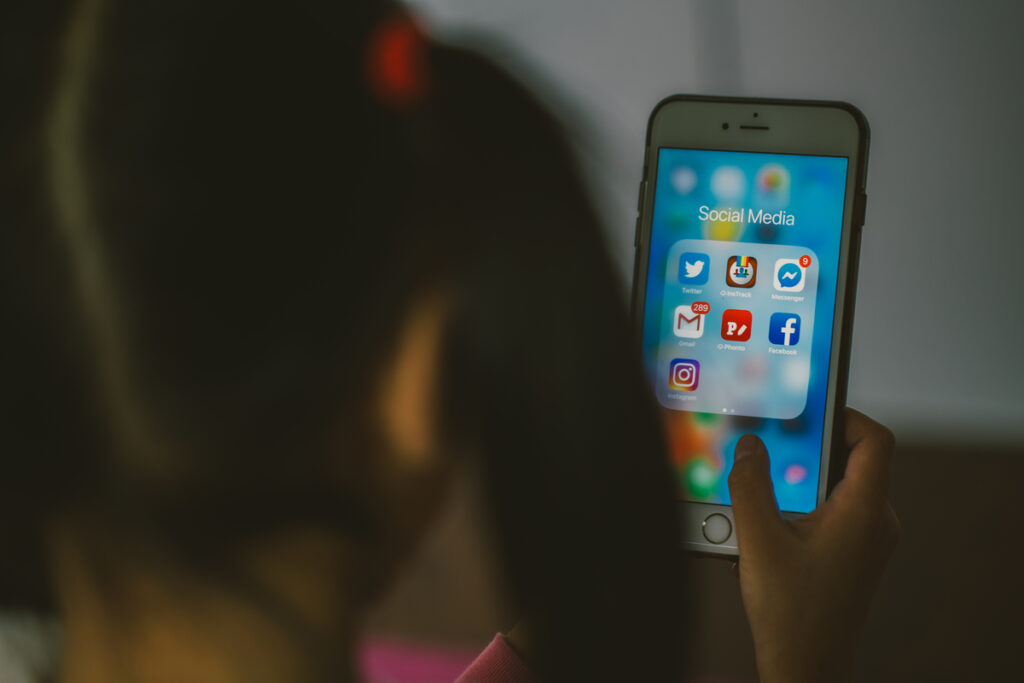The science-fiction genre, both in film and literature, has continually tried to predict what the future might be like. Take, for example, the classic cartoon The Jetsons, which takes us to Orbit City in 2062, to a world of technological advancement beyond our imagination, making life easier, despite the Jetson family’s blunders. Dreamed up by writers in the 1930s and 40ands, they could only imagine where technology would be in 100 years. Some of them lived to see the invention of similar technologies they predicted in the show, such as robotic vacuums, video calling, and robotic assistants (e.g., waiters and waitresses). But the Jetsons is a romanticized vision of the future, one without the challenges of human formation and response to the ubiquity of the technological influx around them. The Anxious Generation identifies what most sci-fi entertainment has never been able to: a direct correlation between the advancement in technology (and in particular social media) and an increase in mental illness. Jonathan Haidt, a professor at NYU, sounds the alarm on what he calls “The Great Rewiring” and how it has affected human behavior, specifically amongst Generation Z (born 1995-2010). Haidt identifies how society failed to set children and families up for success with technology, how the phone-based childhood led to a mental illness epidemic, and what we can do now to push back against this epidemic.
The Anxious Generation begins with a “what-if” illustration where a hypothetical ten-year-old child is chosen to be part of a new human settlement on Mars. The parent in the scenario is asked for permission and the obvious assumption is that no parent would ever send their ten-year-old to Mars unsupervised. This far-fetched illustration is hyperbolic but gets to the heart of what is offered to children when they are given complete access to the virtual world through smart devices. The illustration serves the thesis of the book by sounding the alarms about both the dangers of raising children with unfiltered access to the virtual world while being overly protective of children in the physical world. The context here leads us right up to 2010, the year Haidt identifies as a monumental shift in the relationship between children and mental illness. Leading up to 2010, parents across the board had become much more reluctant to send their kids outside to play unsupervised. This overprotection led children to stay inside, entering a safer physical space but turning to the virtual world of social media, video games, and unfiltered internet access, encountering its own dangers.
2010 is the landmark year in Haidt’s research. It is the year that commences what was referred to earlier as “The Great Rewiring.” The research and data cited by Haidt demonstrate a strong correlation between increased mental health issues such as depression, anxiety, self-harm, and suicide and the “Great Rewiring” within the years 2010 to 2015.
While the ubiquity of technology has increased in the 21st century, it was also found that children were spending less time in “free play”—the creative and social skill-developing time where children interact with one another, decide their own rules, and learn about behaviors. A decrease in “free play” was consistent with an increase in protective measures taken by parents and institutions to keep children safe, both physically and emotionally. Unfortunately, such protective measures prevented children from learning about the different social behaviors that help them form a fundamental cultural understanding about what is right and what is wrong in the spaces they inhabit. Humans, especially those born after 1995, have become more likely to consistently be in a defensive mode, constantly on alert for potential threats, while generally, the generations before acted out of discover mode, a mode that involved risk and opportunity cost. A move away from discover mode and into defense mode led to an unhealthy obsession, both from parents and children, of safety (what Haidt calls “safetyism”). With a rise in safetyism, child dependence on parents increased, taking them away from a free-play childhood, and straight into a childhood in the virtual world. It comes as no surprise that the childhood years are formative, especially during puberty, but the effects of the virtual world on children as well as the move from discover mode to defense mode, exposed a new challenge in childhood development. Specifically, one that we were not prepared for.
As Haidt moves into part two of the book, his focus shifts from the context of “The Great Rewiring” to the behavioral shift amongst Generation Z following “The Great Rewiring.” He begins this section by identifying the four foundational harms of the new phone-based childhood:
- Social Deprivation
- Sleep Deprivation
- Attention Fragmentation
- Addiction
He highlights the evidence for these harms, citing data that shows declines in daily face-to-face interactions amongst children by almost 50%, declines in the quality and quantity of sleep for children, increases in distractions, and increases in behavioral traits for children with smartphones to those with substance addictions.
The next two chapters, titled “Why Social Media Harms Girls More Than Boys” and “What Is Happening to Boys?” highlight how the mental illness surge in children stems from different places while having similar consequences. For young girls, social comparison becomes even more likely to be a catalyst for anxiety and depression due to social media platforms like TikTok and Instagram. Sadly, the phone-based childhood has not only brought an increase in social comparison amongst girls but has brought them onto platforms where they can be stalked, sexualized, and preyed on by men of all ages. For boys, addiction to pornography and video games has stunted their ability to mature, making them fearful of relationships, risk, and showing emotions. Haidt attributes the term anomie, coined by French sociologist Emile Durkheim to the problem for boys. Anomie means “an absence of stable and widely shared norms and rules.” This condition, developed by Durkheim, could be linked to the higher suicide rates for boys. Despite the primary problems being different between boys and girls, mental illness is on the rise for both genders, making either one susceptible to the problems presented by Haidt.
Haidt includes a short chapter devoted to the effects of the phone-based life on spirituality. (Christians will find themselves represented in this category imperfectly). From the beginning of the book Haidt recognizes that the virtual world fundamentally undermines what it means to be human: embodied experience. Replacing the inhabited, or for Christians the incarnational reality, with the out-of-body virtual experience leads people away from one another and towards themselves and their own thoughts and desires. Stemming from this becomes the problems of increased distraction, judgmentalism, and self-centeredness. Drawing on the oft-cited “God-shaped hole” theory, coined by Blaise Pascal, Haidt (even as an atheist) recognizes that technology, the virtual world, and the phone-based life try to occupy this hole. Experience and evidence tell us that these things will never be able to satisfy those innate desires for purpose and meaning that all humans carry.
In the final third of the book, Haidt lays out on the table a few action points for those who want to see change. Most action points fall under the scope of Haidt’s goal of “collective action.” To undo the growing mental health crisis amongst younger generations every sphere of life will need to play an important role. The government can pass legislation and support policies that recognize the growing mental health crisis while working with tech companies to make the virtual world safer. Schools can help themselves by creating phone-free zones or classrooms and giving children more free-play time to tap into discover mode. Parents can support each other by creating a community of kids who receive smartphones and social media at the proper age, or a safe space in the neighborhood to dream and play without intense parental supervision. Haidt is liberal in the amount of potential action points readers and leaders can enact after reading this book. But what about the Church? Are there specific ways Christians can apply The Anxious Generation in the context of the community of faith and with the goal of making Christ and his kingdom known? Here are a few ways I think the Church has an important role to play in fighting back against the phone-based life and the affect it is having on Generation Z.
Contextual Youth Ministry
Haidt highlights a great amount of really important research related to childhood mental illness before and after “The Great Rewiring.” It would be naïve to assume that the research and data in the book do not represent a significant number of children who attend your local church and are involved in your church’s youth ministry. This leaves churches and pastors with either the opportunity to live in fear or denial of these figures or to engage the data, understand the problems, and do important gospel contextualization amongst the youth in their congregation. The gospel is sufficient for each person and to address each and every situation, so meet your students where they are at. Speak gospel truth which addresses their addiction to social media or video games. Show them how finding their identity in Christ frees them from the bondage of catering their image to friends and strangers. Model to them that Christ’s love for his children is worth far more than the praise of their neighbors. Engage the research and combat the current issues children and teens are going through with the gospel of Jesus Christ.
Encourage Congregational Practices
The church is in a strategic place to find success in pushing back against the onslaught of childhood mental illness in our virtually-saturated world. As the church embraces its identity as a community of faith it is in the beneficial place to embrace communal change, such as is suggested by Haidt in the book. Typically, someone gets started with a phone-based childhood because of the pressure from other children their age having it, bringing embarrassment to those children without it, and putting pressure on the parents to give it. Parents in a local church can participate together in creating an environment for their children that is phone-free, screen-time controlled, and collective in action. Children and parents benefit alike from a collective move like this.
Evangelize by Advocacy
As gospel-centered people, it comes as no surprise that Haidt’s book is missing one integral piece: the sufficiency of the gospel. Haidt doesn’t identify as a Christian so we should not be surprised by this, nor should we write off his research (which is empirically sound). Rather, it should be the mission of the church to recognize the growing problems of technology and advocate against them, being clear that the “why?” behind our advocacy is rooted in Christ. Not every issue will be solved via the legal system, but when cases are made, such as age restrictions for social media users and adult content access, Christians have a great opportunity to make the gospel known in why they oppose or affirm proposed legislation. The same could be done on a more practical level during school board meetings, both at public and private institutions, advocating for phone-free classrooms, more recess time, and limited internet access on school properties.
There are many ways the Church has a strategic advantage to find success in what The Anxious Generation hopes to accomplish. Haidt has served us well in sharing both experiences and evidence for why this mental illness epidemic should be important to all of us. New technologies are being invented every day and social media never rests from trying to grab and steal our attention, but Jesus’ compassion for children during his ministry (Mark 9:35-37) should weigh on all of us, stirring in each of us a desire to see change as quickly as possible.
Notes:
Haidt, Jonathan. The Anxious Generation: How the Great Rewiring of Childhood Is Causing an Epidemic of Mental Illness. Penguin Press: New York. 2024.
Published July 23, 2024




